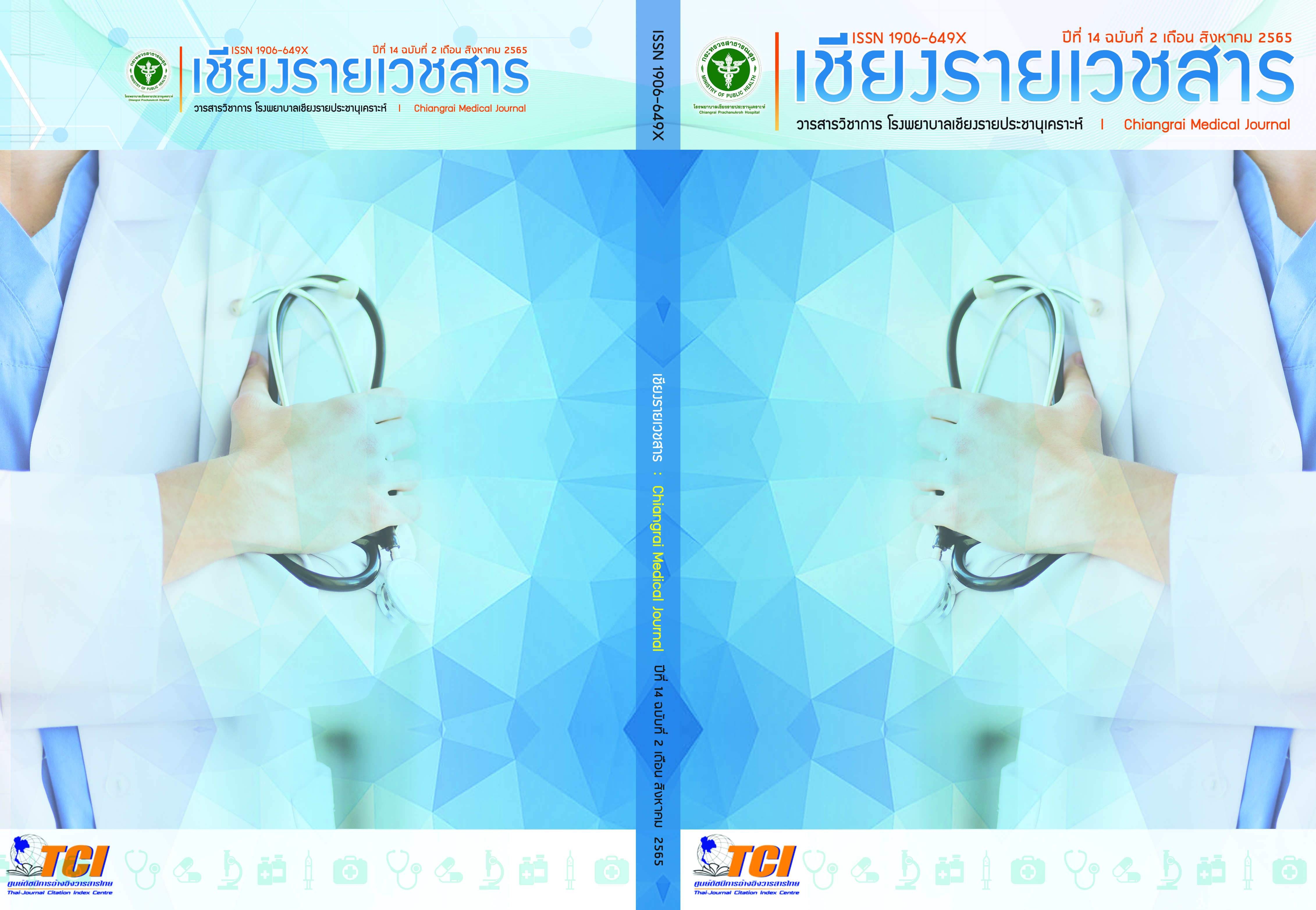The Effects of a Self –efficacy Developing Program to Control Obesity among Secondary School Students at Chiang Rai Municipality
Main Article Content
Abstract
BACKGROUND : School – age obesity is a major public health problem in many countries including Thailand. The increasing trend of this problem may affect the health and development of school-age children in physically, mentally, emotionally, socially and affecting the economic condition of obese children’s families.
OBJECTIVE : To compare self-efficacy, obesity control behavior, body mass index and waist circumference between the self-efficacy development program and usual care group in obesity control.
METHODS : This was a quasi-experimental research. The two groups were measured before and after the experiment. The sample consisted of 60 obese junior high school students. The sample was selected using simple random sampling according to the specified criteria. The Municipal School 5 was an experimental group, and the municipal school 6 was a comparison group, each group consisted of 30 students. The data were analyzed using descriptive statistics and inferential statistics such as Paired t-test, Independent t-test. P- value of 0.05 or less is considered statistically significant.
RESULTS: After using the self-efficacy program, the self-efficacy, and obesity control behavior was significantly different in the experimental group (80.00 ±9.75 vs 70.57± 10.26; p=0.001 and 51.30 ±5.14 vs 46.45± 5.52; p=0.001 respectively). And there were
higher than the comparison group (80.00 ±9.75 vs 73.13± 10.66; p=0.012 and 51.30 ±5.14 vs 46.96± 5.77; p=0.003 respectively). There was not significantly different in body mass index and waist circumference between before and after using the self-efficacy development program. But, the waist circumference of the experimental group was less than the control group (101.36 ±8.74 vs 108.06± 13.21; p=0.024). While, there was not significantly different in body mass index.
CONCLUSIONS AND RECOMMENDATION : The self-efficacy development program for controlling obesity among secondary school student is effective in improving self-efficacy and obesity control behavior. Therefore, this program can be applied to secondary school students in other school. Additionally, this procedure should be conducted with parents of obese children participation because secondary school students are still undertaking the care of their parents who were in effect for eating style.
Article Details

This work is licensed under a Creative Commons Attribution-NonCommercial-NoDerivatives 4.0 International License.
References
Department of Health, Ministry of Public Health. (2014). Guidelines for preventing obesity
in children. Nonthaburi: The Veterans Welfare Organization's Printing House.
Ministry of Public Health. (2019). The percentage of high school-aged children is
proportionate. Retrieved on June 14, 2020. Available from: http://dashboard.anamia.moph.go.
.th/dashboard/overweightstudent
Department of Health, Ministry of Public Health. (2017). Available from: https://dashboard.anamai.moph.go.th/dashboard
Health Data Center 2021 (Internet). Chiang Rai : Chiang Rai Provincial Public Health Office ;
(cited 2022 Aug 2022 ). Available from: http://cri.hdc.moph.go.th.
Bureau of Policy and Strategy Ministry of Public Health. (2013). Summary of important
statistics 2013. Bangkok: The Veterans Welfare Organization's Printing House under the Royal
Patronage of His Majesty the King.
Buasri S. et al. (2020). Food, vegetable and fruit consumption behavior of school-age
children in Chiang Rai Province. Nurse Journal, 47(2), 24 – 36.
Department of Health, Ministry of Public Health. (2017). Health promotion guidelines
prevent disease in school-age children and youth. (5th edition). Bangkok: Office of Academic
Services Silpakorn University.
Phuangmalai O., Muktaphan B. (2018). The relationship of sedentary behavior and obesity
among junior high school students at Satit School Khon Kaen University. Journal of Health
Education, 41(1), 90-102.
Department of Health, Ministry of Public Health. (2016). Handbook of control and
prevention of overnutrition in school-aged children. Bangkok: Or Rung Rueng Printing House.
Bandura, A. (1977). Self Efficacy: Toward Unifying Theory of Behavioral Change.
Suwanampa N., and Salawongluck T. (2019). Effects of behavior modification program
food consumption and exercise to prevent obesity for elementary school students in under
Nakhon Ratchasima Municipality Nakhon Ratchasima Province. Ratchaphruek Journal, 17(1),
-120.
Nam Sook Seo, Young Hee Kim, Hae Young Kang.( 2005 ). Effects of an Obesity Control
Program Based on Behavior Modification and Self-efficacy in Obese Elementary School Children. Journal of Korean Academy of Nursing 2005; 35(3): 611-620. ( cited 19 Jan 2022). Available from : https://doi.org/10.4040/jkan.2005.35.3.611
Anantavan S. ( 2009). Exercise promoting behavior in overweight students.Master of Science ( Public health) Thesis Mahidol University, Bangkok.
Chuchan S., Thongbai W., and Kambutr J. (2014). Effects of the Awareness Promotion
Program.self-efficacy and family support for children's dietary habits Late school age with
overweight condition. Journal of Boromarajonani College of Nursing, Bangkok,32(1), 31-43.
Konthongthom T., Nookong A, and Sangperm P. (2018). Effects of a weight control
program on consumption behavior and physical activity behavior of malnourished school-
aged children. over. Journal of Nursing Chulalongkorn University, 30(2), 28-40.
Injorhor Ch.(2011). Effect of weight loss program on weight loss behavior. BMI Waist circumference of people who are overweight, age group 35-60 years


